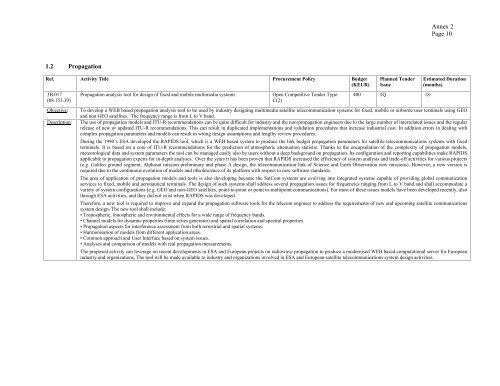ARTES-5.1 â ESA Telecom Technology Workplan ... - Emits - ESA
ARTES-5.1 â ESA Telecom Technology Workplan ... - Emits - ESA
ARTES-5.1 â ESA Telecom Technology Workplan ... - Emits - ESA
- No tags were found...
You also want an ePaper? Increase the reach of your titles
YUMPU automatically turns print PDFs into web optimized ePapers that Google loves.
Annex 2Page 101.2 PropagationRef.alNumber3B.017(08.153.39)Objective:Description:Activity Title Procurement Policy Budget(KEUR)Propagation analysis tool for design of fixed and mobile multimedia systemsOpen Competitive Tender Type:C(2)Planned TenderIssue400 2Q 18Estimated Duration(months)To develop a WEB based propagation analysis tool to be used by industry designing multimedia satellite telecommunication systems for fixed, mobile or airborne user terminals using GEOand non GEO satellites. The frequency range is from L to V band.The use of propagation models and ITU-R recommendations can be quite difficult for industry and the non-propagation engineers due to the large number of interrelated issues and the regularrelease of new or updated ITU-R recommendations. This can result in duplicated implementations and validation procedures that increase industrial cost. In addition errors in dealing withcomplex propagation parameters and models can result in wrong design assumptions and lengthy review procedures.During the 1990’s <strong>ESA</strong> developed the RAPIDS tool, which is a WEB based system to produce the link budget propagation parameters for satellite telecommunications systems with fixedterminals. It is based on a core of ITU-R recommendations for the prediction of atmospheric attenuation statistic. Thanks to the encapsulation of the complexity of propagation models,meteorological data and system parameters the tool can be managed easily also by users without a deep background on propagation. Its configuration and reporting capabilities make RAPIDSapplicable to propagation experts for in-depth analyses. Over the years it has been proven that RAPIDS increased the efficiency of system analysis and trade-off activities for various projects(e.g. Galileo ground segment, Alphasat mission preliminary and phase A design, the telecommunication link of Science and Earth Observation new missions). However, a new version isrequired due to the continuous evolution of models and obsolescence of its platform with respect to new software standards.The area of application of propagation models and tools is also developing because the SatCom systems are evolving into integrated systems capable of providing global communicationservices to fixed, mobile and aeronautical terminals. The design of such systems shall address several propagation issues for frequencies ranging from L to V band and shall accommodate avariety of system configurations (e.g. GEO and non-GEO satellites, point-to-point or point to-multipoint communications). For most of these issues models have been developed recently, alsothrough <strong>ESA</strong> activities, and they did not exist when RAPIDS was developed.Therefore, a new tool is required to improve and expand the propagation software tools for the telecom engineer to address the requirements of new and upcoming satellite communicationssystem design. The new tool shall include:• Tropospheric, ionospheric and environmental effects for a wide range of frequency bands.• Channel models for dynamic properties (time series generator) and spatial correlation and spectral properties• Propagation aspects for interference assessment from both terrestrial and spatial systems.• Harmonisation of models from different application areas.• Common approach and User Interface based on system issues.• Analyses and comparison of models with real propagation measurements.The proposed activity can leverage on recent developments in <strong>ESA</strong> and European projects on radiowave propagation to produce a modernised WEB based computational server for Europeanindustry and organizations. The tool will be made available to industry and organizations involved in <strong>ESA</strong> and European satellite telecommunications system design activities.
















